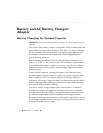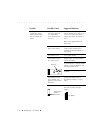
. . . . . . . . . . . . . . . . . . . . . . . . . . . . .
Reference — Camera 7-29
(similar to the levels commonly displayed on audio equipment like tape
decks). The bouncing segments provide feedback, a visual indication that
sound is being recorded. The best quality recording occurs when 4-5
segments are on.
No sound Maximum
Sound files are loosely associated with the image taken before the sound
was recorded.
Recording “Lengthy” Audio Segments
Approximately 25 seconds of uninterrupted sound can be recorded in a
single file. If you press and hold the record button for over 25 seconds, a
slightly different recording action will occur.
The first 25 seconds of audio fills all available dynamic random
access memory. Recording then stops for up to several seconds —
even though the button is still depressed — while the data in memory
are moved to a new file on the PCMCIA card by the camera. Then
recording begins again for another 25 seconds, after which this new
segment of sound is moved to a new sound file on the PCMCIA card,
and so on. Each 25 second segment is stored on the card as a separate
file.
During the interruption between each 25 second segment, the red
Card Busy light on the camera back blinks, and the dot in the disk
icon goes off. These indicate that data are being written to the card,
and that sound is not being recorded.


















